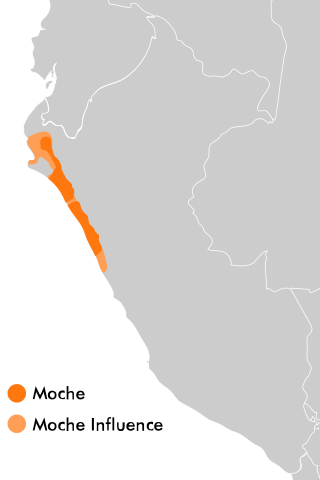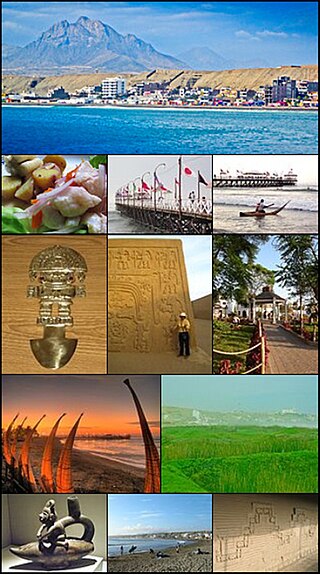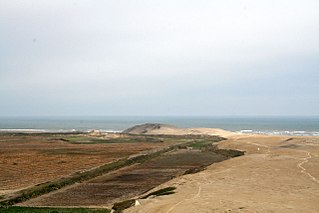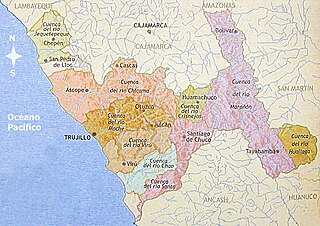
The Moche civilization flourished in northern Peru with its capital near present-day Moche, Trujillo, Peru from about 100 to 700 AD during the Regional Development Epoch. While this issue is the subject of some debate, many scholars contend that the Moche were not politically organized as a monolithic empire or state. Rather, they were likely a group of autonomous polities that shared a common culture, as seen in the rich iconography and monumental architecture that survives today.

Trujillo is a city in coastal northwestern Peru and the capital of the Department of La Libertad. It is the third most populous city and center of the third most populous metropolitan area of Peru. It is located on the banks of the Moche River, near its mouth at the Pacific Ocean, in the Moche Valley. This was a site of the great prehistoric Moche and Chimu cultures before the Inca conquest and subsequent expansion.

La Libertad is a region in northwestern Peru. Formerly it was known as the Department of La Libertad. It is bordered by the Lambayeque, Cajamarca and Amazonas regions on the north, the San Martín Region on the east, the Ancash and Huánuco regions on the south and the Pacific Ocean on the west. Its capital is Trujillo, which is the nation's third biggest city. The region's main port is Salaverry, one of Peru's largest ports. The name of the region is Spanish for "freedom" or "liberty"; it was named in honor of the Intendencia of Trujillo's proclaiming independence from Spain in 1820 and fighting for that. It is the ninth smallest department in Peru, but it is also its second-most populous department after Piura and its second-most densely populated department after Lambayeque.

Huanchaco is a popular seaside resort city in province of Trujillo, Peru. Huanchaco is known for its surf breaks, its caballitos de totora and its ceviche, and is near the ancient ruins of Chan Chan. Huanchaco was approved as a World Surfing Reserve by the organization Save The Waves Coalition in 2012 This historic town is part of the tourist circuit called the "Moche Route" or "Ruta Moche".

Peruvian territory was inhabited 14,000 years ago by hunters and gatherers. Subsequent developments include the appearance of sedentary communities that developed agriculture and irrigation, and the emergence of complex socio-political hierarchies that created sophisticated civilizations, technology and monumental construction.

Ventarrón is the site of a 4,500-year-old temple with painted murals, which was excavated in Peru in 2007 near Chiclayo, in the Lambayeque region on the northern coast. The site was inhabited by the Early Cupisnique, Cupisnique, Chavin and Moche cultures.

Huaca Prieta is the site of a prehistoric settlement beside the Pacific Ocean in the Chicama Valley, just north of Trujillo, La Libertad Province, Peru. It is a part of the El Brujo Archaeological Complex, which also includes Moche (culture) sites.

Santiago de Huamán, simply known as Huaman is a traditional village in Trujillo, Peru; it is located in the western part of the city in Víctor Larco Herrera. Currently its main attractions are the Baroque-style church and the Patron Festivities that are held every year in May or June.

The Foundation of Trujillo is an example of Spanish colonial expansion that took place in the area known today as the Valley of Moche in northern Peru. The exact date of Trujillo's foundation is still in dispute; according to historian Napoleón Cieza Burga it is November 1534.
Open Plaza Los jardines is a shopping center of 25,000 m² located in the Peruvian city of Trujillo, in the locality called Los Jardines, east of the Historic Centre of Trujillo. It belongs to Malls Peru is owned business unit of Falabella Perú. This mall, called format Power Center by the same company, is characterized by at least four local anchor present here as Sodimac and Tottus hypermarkets, smaller operators are also present around anchor stores such as Do it, Coolbox, Boticas BTL, Topitop, etc. and a food court and a Financial Boulevard. This mall was built on what was the former Los Jardines Hotel and it opened on December 3, 2008 with an investment of 26 million dollars. Open Plaza Los Jardines is the 5th mall that Malls Peru company has constructed in the country.
Mallplaza Trujillo is a shopping mall in Trujillo city, Peru. It was opened on November 30, 2007. It is Located in Mansiche avenue near the old locality of San Salvador de Mansiche at northwest the Historic Centre of Trujillo. This mall is the largest in the city and one of the largest in the country. In this shopping center in November 2012 was held the second Gastronomic Fair in Trujillo called Sabe a Peru.
Caja Trujillo, is a Peruvian banking company centered in Trujillo city in the financial sector and currently It is the largest financial company locally, began to operate and provide services in 1985. Up to year 2012 this company has agencies service installed in different regions of the coast and highlands of the Peru providing financial attention mainly to small and medium entrepreneurs in the SME sector. According to a study published in 2010 by the magazine Peru Económico it is one representative mark of the city.

Paseo Pizarro is pedestrian walk located on the main street of Trujillo city, in Peru. Pizarro street in blocks 5,6,7 and 8 becomes exclusively a pedestrian and joins the Plaza de Armas with the Plazuela El Recreo, along its four blocks are numerous landmarks like the Palace Iturregui, the Emancipation House, etc. and businesses such as supermarkets, souvenir shops, cafes and bars, etc.
The Moche Route is a tourist destination that begins in the Peruvian city of Trujillo in what once was the seat of power of the Moche culture known as The Temples of the Sun and the Moon and then goes through a series of places that were part of the kingdoms Moche and Chimu. The route runs along the northern Peruvian mainly through the regions called La Libertad and Lambayeque. In this route, are found the major archaeological sites in this area of Peru, belonging to the Moche culture. Recently the MINCETUR has received the Ulysses Award for the promotion of this tourist route in 2011.

The Lady of Cao is a name given to a female Moche mummy discovered at the archeological site El Brujo, which is located about 45 km north of Trujillo in the La Libertad Region of Peru.
Dulcería Castañeda, is a traditional company and brand of candy in the Peruvian city of Trujillo. Since year 1925 traditionally this company made several kind of candies called alfajors and specially that giant candy called "Alfajor king kong" before known as Alfajor de Trujillo, "Dulcería Castañeda" currently has several local in Trujillo also in Lima city. Its main products are the alfajores requested by tourists as classic sweet souvenirs of the city of the everlasting spring. According to a study published in 2010 by the magazine Peru Económico this is one of the top ten brand of the city.

Chicama Valley is an area located at north of the Valley of Moche in La Libertad Region, northern Peru, it has agricultural resources where one of the main products is cane of sugar; this valley has been formed on both sides of the Chicama River.

Municipality of Victor Larco Herrera is a Peruvian governing body that rules in Victor Larco Herrera district. It is located in Buenos Aires in west of Trujillo city. It has legal autonomy granted by the law of municipalities of Peru

The Quingnam language was a pre-Columbian language that was spoken by the Chimú people, who lived in the former territories of the Mochicas: an area north of the Chicama Chao River Valley. At the height of Chimú conquests, the language was spoken extensively from the Jequetepeque River in the north, to the Carabayllo in the south.
The Chotuna Chornancap Archaeological Complex is an archaeological site in San Jose district, Lambayeque Region, 12 kilometres (7.5 mi) north-west of Chiclayo, Peru of a set of truncated pyramids and compounds, highlighting two pyramids: Chotuna and Chornancap, the first of them believed to be related to the legend of Naylamp. Chotuna was a ceremonial center of the Sican culture, one of the cultures of Pre-Columbian Peru, which developed between the years 700 to 1300 AD. Later the Chimu and then the Inca occupation followed. In 2011 the tomb of the so-called priestess of Chornancap was discovered.

















